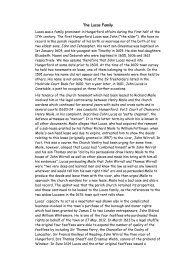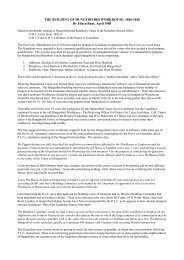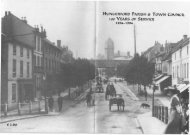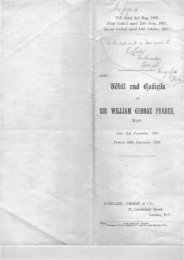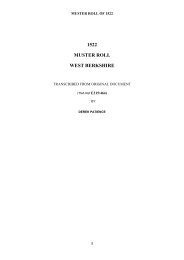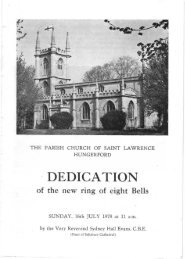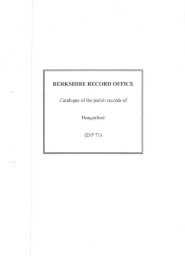The English Country House and Chilton Lodge - Hungerford Virtual ...
The English Country House and Chilton Lodge - Hungerford Virtual ...
The English Country House and Chilton Lodge - Hungerford Virtual ...
Create successful ePaper yourself
Turn your PDF publications into a flip-book with our unique Google optimized e-Paper software.
for their requirements, so the decision was taken to make substantial modifications to the<br />
house.<br />
#24, 25<br />
<strong>The</strong> architectural services of Mr. Griffin of Sutton, Griffin <strong>and</strong> Sweetnam of Newbury were<br />
retained <strong>and</strong> the building contractors were F. Rendell & Sons of Devizes. Griffin was well<br />
known locally <strong>and</strong> already had added an attractive conservatory to West Woodhay <strong>House</strong>.<br />
All the Blomfield accretions to <strong>Chilton</strong> were removed including, sadly, the splendid porte<br />
cochere. A new roof was constructed over the main house <strong>and</strong> the rear of the house was<br />
remodelled to provide kitchens <strong>and</strong> staff (now children's) bedrooms. A new breakfast<br />
room was built on the site of the old Bachelors' Wing. Various changes were made to the<br />
internal layout including moving the dining room from its original location to a much<br />
smaller room, <strong>and</strong> the installation of guest bathrooms <strong>and</strong> hanging cupboards of<br />
Olympian size.<br />
Mr. Griffin's designs for the northern elevation of the house are not attractive. <strong>The</strong><br />
execution by Rendell's also left something to be desired. However, we have every reason<br />
to be extremely grateful that the work was undertaken when planning regulations were<br />
minimal <strong>and</strong> the house could be reduced to a more manageable size. <strong>The</strong> family would<br />
not be living here now if that radical <strong>and</strong> far-sighted surgery had not been carried out at<br />
that time.<br />
POSTSCRIPT<br />
[<strong>The</strong> Historic <strong>House</strong>s Association was founded in the 1970's <strong>and</strong> now has 1,500<br />
house owning members. It's owners have more properties open to the public than<br />
the National Trust <strong>and</strong> <strong>English</strong> Heritage <strong>and</strong> their counterparts in Wales, Scotl<strong>and</strong><br />
<strong>and</strong> Ulster combined. Since more than 75% of 'built heritage' (a horrible term much<br />
used by the Department of Culture, Media <strong>and</strong> Sport) in this country is in private<br />
ownership, those responsible for its upkeep are now more readily heard in the<br />
corridors of power. 10,000 are employed directly by these houses <strong>and</strong> they generate<br />
more than £1.2 billion in revenues a year.]<br />
In 1974, in his essay for the book accompanying the exhibition at the V&A, Roy Strong<br />
wrote "<strong>Country</strong> houses are artefacts created for a system of society which has vanished,<br />
...<strong>The</strong> paternal system of the great house <strong>and</strong> its dependents stretching over the countryside<br />
has gone. But we are left with the superb visual apparatus. Our difficulty lies in divorcing<br />
the one from the other."<br />
I am glad to say that over the last 28 years the divorce has been pretty successful <strong>and</strong> just<br />
about everyone is much happier as a result. What has saved the ECH is its desirability<br />
<strong>and</strong> its flexibility. Whenever a family dies out or gives up the ghost, a queue of new<br />
owners usually forms to take their place.<br />
[Some will be private families who have made or inherited their wealth. Other<br />
country houses will find themselves skilfully filleted into apartments that are<br />
snapped up by those who love the country but whose pockets do not stretch to<br />
owning the whole thing. Other houses become country house hotels, with varying<br />
degrees of success. Still others become corporate headquarters such as Benham<br />
Valence. Some houses, that had been given over to institutional use one or more<br />
generation ago, have come back into private ownership. For example, Farleigh <strong>House</strong><br />
near Basingstoke, for many years a preparatory school, is now once again the home<br />
of the Wallop family, with new restoration <strong>and</strong> wonderful craftsmanship much in<br />
evidence.]<br />
[<strong>The</strong> private owners who live on in these big houses are a determined, if somewhat<br />
dotty, group. <strong>The</strong> temptation to move to a small cottage from their rambling <strong>and</strong><br />
8




